
Science Books
Content
HomeArticles
Gallery
Books
Lego
Personal
Links
Help
Books
Book ListRobot Books
James White
Terry Pratchett
Tom Holt
Larry Niven
Science Books
Miscellaneous Authors
This page contains the science books I have.
- An Introduction to Neural Computing
- De wetten van de vliegkunst
- ARTIFICIAL LIFE
- THE BLIND WATCHMAKER
- FLATLAND
- Het Levens Web
- Klare Lucht, Louter Vuur
- Artificial Life II
- How Brains Make Up Their Minds
- Artificial Life IV
- Artificial Life V
- Advanced Motion Control
- NEUROBIOLOGY, Second Edition
- Self-Organization in Biological Systems
- The Pleasure of Finding Things Out
- Principles of Neurocomputing for Science & Engineering
- De ijzeren wil
- Tranen van de Krokodil
- The Society of Mind
- De wereld van Star Trek
- On Intelligence
- Imitation Of Life
- The Tinkerer's Accomplice
- Emergence
- Follies of Science
- Animal Architects
- Life Without Genes
- Sensors and Seeing in Biology and Engineering
- Musicophilia
- An Anthropologist on Mars
- The Animal Mind

|
An Introduction to Neural ComputingSecond EditionIgor Aleksander, Helen Morton - 1995ISBN 1-85032-167-1 |
Since the publication of the first edition of this best-selling book, there have been some major developments in the area of neural computing which indicate a maturation of the field and the discovery of new targets. This second edition sets out to explain these new developments, focussing on the new techniques and applications of neural systems.
Retaining the fundamental core of the first edition, the authers provide a clear, comprehensive and authoritive account of the subject. The result is a book that will enable readers to obtain a grasp of the essential principles of neural computing, plus an understanding of its history and development. A major part of the revision has been in the area of assessing the development and future perspectives for neural systems, and the book examines areas of application and future research.
An Introduction to Neural Computing has been updated to include:
- New areas of application for neural netwerks which include neurocontrol and financial forecasting.
- A description of commercial and industrial projects - data mining, condition monitoring, neuroforecasting, process monitoring and pattern analisys.
- Revised chapter on the 'weightless' or 'lookup' neural network.
- A new chapter on the latest research including a discussion of the introduction of intentionality into computing through neural systems and a research programme, 'artificial consciousness'.

|
De wetten van de vliegkunstOver stijgen, dalen vliegen en zwevenHenk Tennekes - 1992ISBN 90-6834-095-6 |
Meikever, huismus, kolibri, knobbelzwaan, wedstrijdvlieger, hangglider, parawing, Fokker Friendship, Boeing 747: het gehoorzaamt allemaal aan dezelfde wetten van de vliegkunst. Allemaal hebben ze vleugels nodig, en die moeten niet te klein, maar ook niet te groot zijn. Vaak leidt dit tot fantastische resultaten: een lange vliegreis bij een snelheid van bijna duizend kilometer per uur kost maar een dubbeltje per persoon per kilometer. Dat haalt het openbaar vervoer bij lange na niet.
In dit boek wordt duidelijk gemaakt hoe dat allemaal komt, en dat u vooral geen Porsche of Ferrari moet kopen als u 300 km/u wilt rijden, maar met de TGV moet gaan. Ook dat de supersone Concorde (het vervoermiddel van playboys, popsterren en bovenbazen) veel te grote vleugels heeft, waarom ganzen het gedartel van leeuweriken niet kunnen nadoen, en hoe het de mens na vele eeuwen dromen tenslotte nooit gelukt is om op eigen kracht te vliegen. Dit boek prikkelt u om na te denken over alles wat vliegt: muggen die slim genoeg zijn om te wachten tot de wind gaat liggen, leeuweriken die de Golf van Mexico oversteken als ze de wind in de rug hebben, en kolibries die net als straaljagers in de lucht moeten bijtanken omdat ze zoveel brandstof verbruiken.
Kortom: vliegkunst voor iedereen die nieuwsgierig genoeg is om zelf eens wat te willen rekenen, die wil weten waarom een albatros slanke vleugels heeft, waarom een parkietje werd doorgemeten in een windtunnel, een waarom de Boeing 747 zo'n bijzonder vliegtuig is. Een boek waarmee u weg kunt dromen, juist omdat het met beide benen op de grond staat. Een boek voor iedereen die, net als de auteur, gefascineerd is door de technische wonderen van de vliegkunst.

|
ARTIFICIAL LIFEThe Quest For A New CreationSteven Levy - 1992ISBN 0-14-023105-6 |
Living creatures grow, fight with each other, feed, reproduce and die. So do the 'organisms' that pioneers of artificial life create on computer screen. A simple programme can generate an unexpected mollusc-shell pattern. A flick of a switch can start up a flock of 'boids' (simulated flocking birds) which swerve around obstacles just like real birds. Populations of artificial ants, animats, biomorphs and computer viruses are increasing all the time. And, once set in motion, they are on their own, spontaneous and incredibly life-like. This extraordinary new world of artificial life has been developed by a colourful alliance of geniuses and iconoclasts. Steven Levy explores their astonishing discoveries, our new understanding of intelligence and evolution, and the 'codes' which may govern real animals' behaviour. For those who are sure they know what life is, this book offers some fascinating surprises.

|
THE BLIND WATCHMAKERRichard Dawkins - 2000ISBN 0-140-29122-9 |
Richard Dawkins's brilliant and controversial book has become a landmark account. Here he vividly demonstrates that evolution by natural selection - the unconscious, automatic, blind yet essentially non-random process discovered by Darwin - is the only answer to the biggest question of all: why do we exists?

|
FLATLANDA Romance Of Many DimensionsEdwin A. Abbott - 1984ISBN 0-451-52290-7 |
With wry humor and penetrating satire, Flatland takes us on a mind-expanding journey into a different world to give us a new vision of our own. A. Square, the slightly befuddled narrator, is born into a place which is limited to two dimensions - irrevocably flat - and peopled by a hierarchy of geometrical forms. In a Gulliver-like tour of his bizarre homeland, A. Square spins a fascinating tale of domestic drama and political turmoil, from sex among consenting triangles to the intentional subjugation of Flatland's females. He tells of visits to Lineland, the world of one dimension, and Pointland, the world of no dimension. But when A. Square dares to speak openly of a third, even a fourth dimension, his tragic fate climaxes a brilliant parody of Victorian society. An underground favorite since its publication in England in 1884, Flatland is as prophetic a science-fiction classic as the works of H.G. Wells, introducing aspects of relativity and hyperspace years before Einstein's famous theories, and it does so with a wonderful, enduring enchantment.
With an Introduction by A.K. Dewdney

|
Het Levens WebFritjof Capra - 1996ISBN 90-215-2993-9 |
Het mysterie van het leven fascineert. Wat is de kracht die geest en materie, mens en natuur, individu en samenleving verbindt? In zijn nieuwe boek slaagt Fritjof Capra erin, ons het leven te laten zien en begrijpen - op alle niveaus en in alle verschijnings vormen.
Als briljante uitlegger zet Capra onvoorstelbaar helder en inspirerend de nieuwe inzichten in biologie, neurologie, wiskunde, sociale wetenschappen en filosofie uiteen: de eenvoud in het complexe, de patronen in de chaos, de rol van het bewustzijn in het klein en in het groot. De hele werkelijkheid bestaat op vele verschillende niveaus uit zelforganiserende systemen - het 'levensweb'. Dat is het verbluffend herkenbare én vruchtbare fundament voor wetenschap en filosofie, zakenleven en gezondheidszorg, en speciaal voor de ecologie. Het ontdekken van dit levensweb, aan de hand van Fritjof Carpa, is een zeldzaam rijke ervaring die ons blijvend verandert. En de mens speelt in deze ontwikkeling - net als alle andere vormen van leven - ook een scheppend rol!
Dit is het nieuwe standaard werk van de 'new science'. Geschreven voor de niet-wetenschapper. Daarom is het voor iedereen die zich door Capra's inzichten wil laten inspireren een uiterst informatieve en facinerende leeservaring.
Fritjof Capra maakte onder andere naam met zijn eerdere bestsellers De Tao van Fysica, Het Keerpunt en Het Nieuwe Denken.

|
Klare Lucht, Louter VuurOver de stoffelijke oorsprong van denken en bewustzijnGerald M. Edelman - 1993ISBN 90-351-1204-0 |
Wat maakt een mens anders dan een ding? In Klare lucht, louter vuur gunt een van 's werelds meest vooraanstaande hersenonderzoekers ons een blik in de werking van het menselijke brein - het meest complexe stoffelijke object in het universum. Een hoeveelheid hersenmatriaal ter grootte van de kop van een lucifer bevat ongeveer een miljard verbindingen die met elkaar combinaties aangaan op een manier die alleen maar kan worden omschreven als hyperatronomisch - in de orde van grootte van tien gevolgd door miljoenen nullen (het aantal positief geladen deeltjes in het hele bekende heelal bedraagt slechts circa tien gevolg door tachtig nullen).
Gerald Edelmand stelling is dat biologische, evolutionaire processen de sleutel vormen tot het begrijpen van de hersenen en uiteindelijk van de menselijke geest.
De auteur rekent af met cognitieve en op gedrag gerichte benaderingen waarin biologie geen rol speelt, net als met het tegenwoordig zo populaire beeld van het brein als computer. Volgens Edelman lijkt het functioneren van de hersenen veel meer op de levende ecologie van een oerwoud dan op de activiteiten van een elektriciteits bedrijf.
Er is geen grotere wetenschappelijke uitdaging denkbaar dan het begrijpen van de hersenen. Klare lucht, louter vuur brengt de lezer een grote stap verder.
Gerald M. Edelman is directeur van het Neurosciences Institute en hoofd van de afdeling neurobiologie aan het Scripps Research Institute. In 1972 kreeg hij de Nobelprijs voor de geneeskunde. Hij is de auteur van de trilogie Neural Darwism (1987), Topobiology (1988) en The Remembered Present (1989), waarvan Klare lucht, louter vuur een ook voor de geïntresseerde leek begrijpelijke samenvatting is.

|
Artificial Life IIProceedings of the Workshop on Artificial LifeChristopher G. Langton - 1990ISBN 0-201-52571-2 |
Artificial life is a new field of scientific inquiry that studies biology by attempting to synthesize such biological phenomena as life, evolution, and ecological dynamics within computers and other "artificial" media. In addition to uncovering new ways to study life as we know it, a life extends research to the larger domain of life as it could be, whatever it might be made of and wherever it might be found in the universe.
This proceedings volume, based on the second artificial life workshop held in Santa Fe, New Mexico, 1990, reflects the evolution and horizons of this rich field of study, and builds on the proceedings of the seminal first workshop, held at Los Alamos in 1987 (also available from Addison Wesley). This compendium includes more than 30 papers spanning the spectrum of a-life research, from studies of the origin of life to models of complex ecosystems.
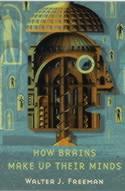
|
How Brains Make Up Their MindsWalter J. Freeman - 1999ISBN 0-75381-068-9 |
How do we exercise our will? How do we control our behaviour and make sense of the world around us? Do our genes and environment determine all that goes on in our brains, or do we create ourselves through what we believe and how we behave?
In How Brains Make Up Their Minds, Walter J. Freeman charts the brain's mind, progressing from single nerve cells to co-operative nerve cell assemblies to the emergence of complex brain patterns. By drawing on new developments in brain imaging and theories of chaos and nonlinear dynamics, he shows how brains create intentions and meanings. In doing so he finds new ways to answer age-old philosophical questions about self-determination and individual responsibility.
Freeman's novel synthesis of neuroscience and philosophy shows that the power to choose is an essential and inalienable property of brains, and that it is the foundation for the development and flourishing of individuals and societies.
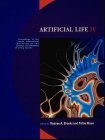
|
Artificial Life IVProceedings of the Fourth International Workshop on the Systhesis an Simulation of Living SystemsRodney A. Brooks, Pattie Maes - 1994ISBN 0-262-52190-3 |
The field of artificial life has recently emerged through the interaction of research in biology, physics, parallel computing, artificial intelligence, and complex adaptive systems. Researchers in artificial life seek to understand, through synthetic experiments, the organizational principles underlying the dynamics (usaually the nonlinear dynamics) of living systems. This book brings together contributions to the Fourth Artificial Life Workshop, held at the Massachusetts Institute of Technology in the summer of 1994.
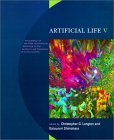
|
Artificial Life VProceedings of the Fifth International Workshop on the Systhesis an Simulation of Living SystemsChristopher G. Langton, Katsunori Shimohara - 1997ISBN 0-262-62111-8 |
"Despite all the successes in computer engineering, adaptive computation, bottom-up AI, and robotics, artificial life must not become simply a one-way bridge, borrowing biological principles to enhance our engineering efforts in the construction of life-as-it-could-be. We must ensure that we give back to biology in kind, by developing tools and methods that will be of real value in the effort to understand life-as-it-is." - Christopher G. Langton
Artificial Life V marks a decade since Christopher Langton organized the first workshop on artificial life - a decade characterized by the exploration of possibilities and techniques as researchers have sought to understand, through synthetic experiments, the organizing principles underlying the dynamics (usually the nonlinear dynamics) of living systems. In addition to presenting the latest work in the field, Artificial Life V includes a retrospective and prospective look at both artificial and natural life with the aim of refining the methods and approaches discovered so far into viable, practical tools for the pursuit of science and engineering goals.
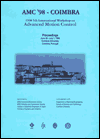
|
Advanced Motion Control1998 5th International WorkshopAnibal T. De Almeida, Helder Araujo, Kouhei Ohnishi, Masayoshi Tomizuka, Werner Leonhard - 1998ISBN 0-7803-4484-7 |
The objectives of and solutions to motion control problems are thoroughly analyzed in is international workshop. Approaches such as mathematical modeling are examined for performance accuracy and reliability in test equipment. This workshop features reviews of alternatives such as adaptive control and robust designs for attaining high performance system.

|
NEUROBIOLOGY, Second EditionMolecules, Cells and SystemsGary G. Matthews - 2001ISBN 0-632-04496-9 |
From one of the most acclaimed neurobiology authers and scholars, Gary G. Matthews returns to his research with his most ambitious update of Neurobiology: Molecules, Cells, and Systems, Second Editions. Professor Matthews has written a thorough, student-friendly introduction to basic principles of neural function for undergraduates. Instead of a broad and neccessarily superficial survey of all neurobiology, particular examples have been selected to illustrate functional principles at the cellular, molucular, and neural-system levels. The book emphasizes basic properties of nerve cells and neural circuits, giving a foundation for further learning. A the second edition of a very succesful neurobiology book, this text ranges from molecules to systems and uses various systems to illustrate each major concept.
"Both the style and the substance of the book are characterized by a consistent aesthetic of clarity, simplicity, and economy. More information is deliverd per page than in any competing text, yet uncluttered. Matthews demonstrates a gift for rendering complicated and sometimes subtle mechanisms accessible to the average reader while providing the more ambitious student with plenty of food for thought." - Professor Peter Shizgal, Concordia University Canada
"The text is very clearly writen. This would help students understand complex principles. There is a good numerical approach to the Nernst equation and basic electrophysiological principles of membrane potential. I like the idea of having an appendix devoted to this important topic, too." - Professor Kate Susman, Vassar College
Audience
Undergraduate students enrolled in introductory courses in neurobiology, neurophysiology, and neuroscience taught in biology, psychology, and for students in the pre-medicine track.
What sets this textbook apart?
- Emphasizes basic properties of nerve cells and neural circuits and, within each topic, specific examples illustrate fundamentals of nervous system function.
- Includes thorough coverage of nervous system structure, developoment and plasticity, the organization of sensory and motor systems, and electrical and chemical communications in the nervous system.
- Contains boxed sections on current techniques and human disease.
- Stresses the cellular/molecular basis of neurobiology.
- Comprehensive text with excellent coverage of subjects from molecules to systems.
- Use of systems to illustrate each major concept.
New to this edition
- New four-color design.
- Integrated companion website for additional teaching and learning tools.
- Includes two new chapters: hypothalamic function with focus on circadian rhythms and language and cognitions.
- More clinical correlations.
- New pedagogical devices.
- Learning tools include: "In the clinic" boxes, "Advanced Topics", Internet Assigments", "Key Points", and "Review Questions".
- An extensive glossary has been added.
- Features three "Advanced Topics": Derivations of the Nernst and Goldman Equations, Eletrical Properties of Cells, and Analysis of Ion Channel Gating.

|
Self-Organization in Biological SystemsScott Camazine, James Sneyd, Jean-Louis Deneubourg, Guy Theraulaz, Nigel R, Franks, Eric Bonabeau - 2001ISBN 0-691-01211-3 |
The synchronized flashing of fireflies at night. The spiraling patterns of an aggregating slime mold. The coordinated movements of a school of fish. Researchers are finding in such patterns - phenomena that have fascinated naturalists for centuries - a fertile new approach to understanding biological systems: the study of self-organization. This book, a primer on self-organization in biological systems for students and other enthusiasts, introduces readers to the basic concepts and tools for studying self-organization and then examines numerous examples of self-organization in the natural world. Broad in scope, thorough yet accessible, this book is a self-contained introduction to self-organization and complexity in biology - a field of study at the forefront of life sciences research.

|
The Pleasure of Finding Things OutThe Best Shot Works of Richard P. FeynmanRichard P. Feynman - 2000ISBN 0-7382-0349-1 |
"A sparkling collection." -Wall Street Journal
"This marvelous collection of talks, interviews, and essays offers a memorable sample of the wit, brilliance, and irreverence of the most celebrated physicist of our time. The more one reads of Feynman, the more one falls in love with his refreshingly enthusiastic view of the world." -Alan Guth, author of The Inflationary Universe
"Feynman's distinctive voice rings out in this book." -Scientific American
"A delightful reminder of Feynman's prodigious gifts." -Nature
The late Richard P. Feynman won the 1965 Nobel Prize in physics for his many contributions to physics, especially for hir work on quantum electrodynamics. One of the most famous and beloved figures of our era, both in physics and in the public arena, he is the author of many popular and scholarly books, including The Meaning of It All and Six Easy Pieces, which was named one of the best 100 nonfiction books of the twentieth century by The Modern Library.

|
Principles of Neurocomputing for Science & EngineeringFredric M. Ham, Ivica Kostanic - 2001ISBN 0-07-025966-6 |
Principles of Neurocomputing for Science & Engieering iss an exciting new textbook intented for individuals who want to understand the underlying principles of artificial neural networks for neurocomputing and for those who want to be able to apply various neurocomputing techniques to solve real-world problems in science and engineering. Neurocomputing can be applied to problems such as pattern recognition, optimization, event classification, control and identification of nonlinear systems, and statistical analisys - just to name a few. This book is intented for a course in neural networks.
Key features of this book include:
- Algorithms - Most training algorithm are highlighted for easy reference.
- MATLAB Functions - Some of the training algorithms have an accompanying MATLAB function implementation given in the text (also highlighted). The code is relatively short and takes only a few minutes to enter into MATLAB.
- MATLAB Toolbox - The MATLAB Neural Network Toolbox is used extensively to illustrate certain neurocomputing concepts.
- Website - Data for some of the problems in this book can be easily accessed through the McGraw-Hill Higher Education website for this book at http://www.mhhe.com/engcs/electrical/ham
- Examples - Detailed examples are presented in most sections to illustrate important neurocomputing concepts.
- Problem Sets - An extensive set of problems applying neurocomputing techniques is givin at the end of each chapter. Some problems require the use of MATLAB and the MATLAB Neural Network Toolbox. In sme cases the code contains is provided for the MATLAB function.
- Comprehensive Appendix - Appendix A contains a comprehensive mathematical foundation for neurocomputing.
Ivica Kostanic works is a Senior RF Engineer and a researcher at Agilent Technologies, Inc., Melbourne, Florida.

|
De ijzeren wilOver bewustzijn, het brein en denkende machinesBas Haring - 2003ISBN 90-467-0341-X |
Dat computers intelligente machines zijn merken we dagelijks; en konijnen - of dieren in het algemeen - zijn meestal ook niet op hun achterhoofd gevallen. Toch lijkt het alsof er een speciaal plekje is voor de mens, de intelligentste van allemaal. Veel mensen hebben het gevoel dat wij iets extra's hebben ten opzichte van dieren en machines: een ziel, bewustzijn, of een wil. Maar is dit gevoel terecht?
De IJzeren wil gaat over kunstmatige intelligentie en over de filosofische vragen die daaraan verbonden zijn. De IJzeren wil geeft niet per se antwoorden, maar laat wel zien hoe je op een intelligente manier met dit soort vragen om kan gaan. Speels, en met voorbeelden uit het dagelijkse leven.
"Waarom wint de computer met schaken, maar de mens in de liefde? Geestige en heldere non-fictie, onnavolgbaar geïllustreerd." -NRC Handelsblad

|
Tranen van de KrokodilOver de snelle evolutie van onze hersenenPiet Vroon - 2006ISBN 90-414-0553-4 |
In de klassieker Tranen van de krokodil beschrijft Piet Vroon (1939-1998) ons doen en laten met behulp van psychologische gegevens en beschouwingen over de manier waarop onze hersenen in historisch perspectief tot stand zijn gekomen. Centraal in dit boek staat de stelling dat evolutie langzaam te werk gaat, maar dat het tempo sterk verhoogt als er een groot probleem in de omgeving rijst. Zo wordt aan de langdurig 'uitgeteste' delen van het zenuwstelsel in korte tijd een nieuw systeem met nieuwe taken en mogelijkheden toegevoegd.
Douwe Draaisma, met wie Piet Vroon samenwerkte voor het boek De mens als metafoor, schreef voor deze uitgaven een nawoord.
"Daarmee is de Nederlandse intelligentsia iemand kwijtgeraakt die nog lang niet gemist kon worden omdat er maar zo weinig van zijn. Iemand die de brede intellectuele mogelijkheden had om de platgetreden paden te verlaten. Iemand die de moed had zijn eigen vertrouwde omgeving te verlaten om zijn tegenstanders op voor hem vreemd terrein tegemoet te treden, desnods ten koste van een overwinning, maar onzin diende hoe dan ook te worden bestreden." - Filosofie Magazine
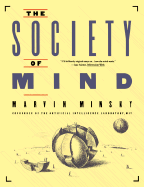
|
The Society of MindMarvin Minsky - 1986ISBN 0-671-65713-5 |
"A stunning collage of staccato images, filled to the brim with witty insights and telling aphorisms." -Douglas Hofstadter, author of Gödel, Escher, Bach and Metamagical Themas
Marvin Minsky - one of the fathers of computer science and cofounder of the Artificial Intelligence Laboratory at MIT - gives a revolutionary answer to the age-old question: "How does the mind work?"
Minsky brilliantly portrays the mind as a "society" of tiny components that are themselves mindless. Mirroring his theory, Minsky boldly casts The Society of Mind as an intellectual puzzle whose pieces are assembled along the way. Each chapter - on a self-contained page — corresponds to a piece in the puzzle. As the pages turn, a unified theory of the mind emerges, like a mosaic. Ingenious, amusing, and easy to read, The Society of Mind is an adventure in imagination.
"INGENIOUS...STIMULATING...crisp, packed with quips, aphorisms and homely illustrations. A pleasure to read...It will make you think. And that's what brains are for." -The New York Times Book Review
"PROVOCATIVE, DELIGHTFUL, CHALLENGING, a rich, funny and altogether fascinating book." -Michael Crichton, author to The Andromeda Strain
"SPARKLING WITH JOKES and apt quotations...and rich insights." -Martin Gardner, The Boston Sunday Globe

|
De wereld van Star TrekNatuurkundige fictie of natuurkundige feiten?Lawrence M. Kraus - 1996ISBN 90-274-3327-5 |
"Tussen wetenschap en sciencefiction bestaat er tweerichtingsverkeer. De natuurkunde die in de wereld van Star Trek een rol speelt, is zeker een nader onderzoek waard." -Uit het Voorwoord van Stephen Hawking
- Hoe werkt een warp-drive precies?
- Wat is het verschil tussen een holodek en een hologram?
- Wat gebeurt er als je wordt 'opgestraald'?
- Wat is het verschil tussen een wormgat en een zwart gat?
- Wat is antimaterie en waarom heeft de Enterprise die nodig?
- Is het mogelijk om te reizen in de tijd en kan ik mijn vader vermoorden nog voor ik geboren ben?
Lawrence M. Krauss is hoogleraar natuurkunde en astronomie; hij is hoofd van de Afdeling Fysica van de Case Western Reserve Universiteit.
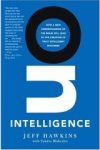
|
On IntelligenceHow a new understanding of the brain will lead to the creation of truly intelligent machinesJeff Hawkins, Sandra Blakeslee - 2005ISBN 0-8050-7853-3 |
Jeff Hawkins, the man who created the PalmPilot, Treo smart phone, and other handheld devices, has reshaped our relationship to computers. Now he is revolutionizing neuroscience and computing with his new look at intelligence itself.
In On Intelligence, Hawkins develops a powerful theory of how the human brain works, explaining why computers are not intelligent. The brain is not a computer, but a memory system that stores experiences in a way that reflects the true structure of the world, remembering sequences of events and their nested relationships and making predictions based on those memories. It is this memory-prediction system that forms the basis of intelligence, perception, creativity, and even consciousness. Based on this new theory, we can finally build intelligent machines, ones that will likely exceed human ability in suprising and useful ways.
Written with acclaimed science writer Sandra Blakeslee and endorsed by a host of scientists and thechnology experts, On Intelligence reveals how we truly think and how thiss will transform the technology age.

|
Imitation Of LifeHow biology is inspiring computingNancy Forbes - 2004ISBN 0-262-06241-0 |
As computers and the tasks they perform become increasingly complex, researchers are looking to nature - as model and as metaphor - for inspiration. The organisation and behaviour of biological organisms present scientists with an invitation to reinvent computing for the complex tasks of the future. In Imitation of Life Nancy Forbes surveys the emerging field of biologically inspired computing, looking at some of the most impressive and influential examples of this fertile synergy.
Forbes identifies three strains of biologically inspired computing: the use of biology as inspiration for the development of algorithms; the construction of information processing systems that use biological materials or are modelled on biological processes, or both; and the effort to understand how biological organisms "compute," or process information. Forbes then shows us how current researchers are using these approaches. She looks at artificial neural networks; evolutionary and genetic algorithms, which search for the "fittest" among a generation of solutions; cellular automata; artificial life - not just a simulation, but "alive" in the internal ecosystem of the computer; DNA computation, which uses the encoding capability of DNA to devise algorithms; self-assembly and its potential use in nanotechnology; amorphous computing, modelled on the kind of cooperation seen in a colony of cells or a swarm of bees; computer immune systems; biohardware and how bioelectronics compares to silicon; and the "computational" properties of cells.
Nancy Forbes works as a science and technology analist for the federal government. She has advanced degrees both in physics and the humanities, and has served as a contributing editor for The Industrial Phycicist and Computing in Science and Engineering.
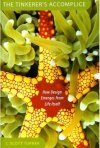
|
The Tinkerer's AccompliceHow Design Emerges from Life ItselfJ. Scott Turner - 2007ISBN 0-674-02353-6 |
Most people, when they contemplate the living world, conclude that it is a designed place. So it is jarring when biologists come along and say this is all wrong. What most people see as design, they say - purposeful, directed, even intelligent - is only an illusion, something cooked up in a mind that is eager to see purpose where none exists. In these days of increasingly assertive challenges to Darwinism, the question becomes acute: is our perception of design simply a mental figment, or is there something deeper at work?
Physiologist Scott Turner argues eloquently and convincingly that the apparent design we see in the living world only makes sense when we add to Darwin's towering achievement the dimension that much modern molecular biology has left on the gene-splicing floor: the dynamic interaction between living organisms and their environment. Only when we add environmental physiology to natural selection can we begin to understand the beautiful fit between the form life takes and how life works.
In "The Tinkerer's Accomplice", Scott Turner takes up the question of design as a very real problem in biology; his solution poses challenges to all sides in this critical debate.
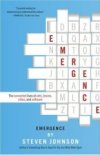
|
EmergenceThe connected lives of ants, brains, cities and softwareSteven Johnson - 2004ISBN 0-684-86876-8 |
In the tradition of Being Digital and The Tipping Point, Steven Johnson, acclaimed as a "cultural critic with a poet's heart" (The Village Voice), takes readers on an eye-opening intellectual journey trough emergence theory and its applications. Explaining why the whole is sometimes smarter than the sum of its parts, Johnson presents suprising examples of feedback, self-organization, and adaptive learning. How does a lively neighborhood evolve out of a disconnected group of shopkeepers, bartenders, and real estate developers? How does a media event take on a life of its own? How will new software programs create an intelligent World Wide Web?
In the coming years, the power of self-organization - coupled with the connective technology of the Internet - will usher in a revolution every bit as significant as the introduction of electricity. Provocative and engaging, Emergence puts you on the front lines of this exciting upheaval in science and thought.
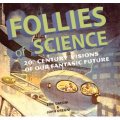
|
Follies of Science20th Century Visions of Our Fantastic FutureEric Drengni, Jonathan Dregni - 2006ISBN 1-933108-09-6 |
The twentieth century's futuristic utopian plans for your home and lifestyle - in vivid color and detail!
Highlights Include:
- Transportation Wonders of all sorts
- Computers and Robots
- Inventing Away War
- Medical Marvals
- Space Colonies
- Predictions for the Next Generation
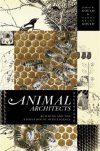
|
Animal ArchitectsBuilding and the Evolution Of IntelligenceJames R. Gould, Carrol Grant Gould - 2007ISBN 0-465-02782-2 |
How do birds and beavers build elaborate dwellings that require immense forethought? How can rodents or termites build structures that surpass human engineering? Can we really explain such feats of as the product of instinct? Animal behaviour has long been a battleground between the competing claims of nature and nurture. Only resently has the possible role of animal cognition entered the debate. Animal Architects explores an untapped trove of behavioural data to investigate how the structure an animal builds reveals the inner workings of its mind.
Beginning with instinct and the simple homes og solitary insects, and progressing to conditining, the "cognitive map", and the role of planning and insight, James and Carol Gould use the amazing feats throughout the animal world - from silken tunnels and wax lairs to clay towers - to reach groundbreaking conclusions about animals' behavioral capabilities. As revealed by their constructins, the range of animal cognition runs from spiders whose web blueprints are largely innate to bower birds whose nests clearly show intellectual intellectual insight, planning, and even aesthetics.
The most complex mysterious animals of all - humans - do not escape analysis. The authers reflect on what animal buildings tells us about the nature of human intelligence, showing why human, unlike many animals, need t build their castles in the air.
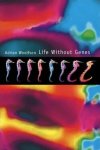
|
Life Without GenesAdrian Woolfson - 2000ISBN 0-00-255618-9 |
What is life? What are genes? Can life exist without genes? What will living things be like in the future and how did life evolve in the first place? Taking us beyond biology and genes, through ground-breaking analysis of all the genetic clues contained in each of us, Adrian Woolfson broadens and changes our view of the future forever.
Crystal clear and jargon-free, Life Without Genes is packed with vivid and surreal examples drawn from the world around us. Could a pufferfish behave like a fly? Might giraffes grow taller than skyscrapers? How are crocodiles able to stay underwater for more than an hour? Is it possible to turn a stickleback into a daffodil, or a tiger into a porcupine? Woolfson asks us to imagine a hypermarket stocked with every possible type of toy in the universe, to see DNA as a infinitely flexible Lego, and he takes us on swirling Peter Pan-like trips through the past, present and future of our own genes and shows us the full scope (and perils) of genetic engineering.
A uniquely accessible work of science, with shades of Huxley, Lewis Carroll and Darwin, Life Without Genes presents a truly startling vision of a future where the consequences of our current genetic experiments turn out to be both stranger and more foreign than we ever imagined. It shows a world dominated by artificially constructed biological machines, and suggests that the very genetic codes, DNA and protein building block materials of contemporaty living things, might themselves one day be supplanted by more alternative designs and technologies. Our conception of life, evolution - and genetics - will never be the same again.
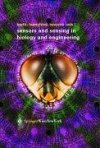
|
Sensors and Seeing in Biology and EngineeringFriedrich G. Barth, Joseph A.C. Humphrey, Timothy W. Secomb - 2003ISBN 3-211-83771-X |
Biological sensors usually are remarkably small, sensitive and efficient. It is highly desirable to integrate fundamental principles observed in natural sensorsin the design and fabrication of corresponding artificial sensors for scientific, industrial and commercial purposes. This book is designed to fill an urgent need for interdisciplinary exchange between biologists studying sensors in the natural world and engineers and physical scientists developing artificial sensors. Contributions from leading engineers and scientists have been written in depth while remaining accessible to readers from these and other disciplines.
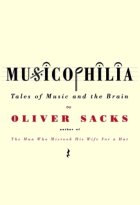
|
MusicophiliaTales of Music and the BrainOliver Sacks - 2007ISBN 978-0-330-444436-1 |
Music can move us to the heights or depths of emotion. It can persuade us to buy something, or remind us of our first date. It can lift us out of depression when nothing else can. It can get us dancing. But the power of music goes much, much further. Indeed, music occupies more areas of our brain than language does - humans are a musical species.
Oliver Sacks's compassionate, compelling tales of people struggling to adapt to different neurological conditions have fundamentally changed the way we think of our own brains, and of the human experience. In Musicophilia, he examines the powers of music through the individual experiences of patients, musicians, and everyday people - from a man who is struck by lightning and suddenly inspired to become a pianist at the age of forty-two, to an entire group of children with Williams syndrome who are hypermusical from birth.
Our exquisite sensitivity to music can sometimes go wrong: Sacks explores how catchy tunes can subject us to hours of mental replay, and how a surprising number of people acquire nonstop musical hallucinations. Yet far more frequently, music goes right: it can animate people with Parkinson's disease who cannot otherwise move, give words to stroke patients who cannot otherwise speak, and calm and organize people whose memories are ravaged by Alzheimer's or amnesia.
Music is irresistible, haunting, and unforgettable, and in Musicophilia, Oliver Sacks tells us why.
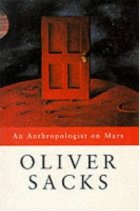
|
An Anthropologist on MarsOliver Sacks - 1995ISBN 978-0-330-34347-3 |
'Nobody is like Sacks... The seven "cases" in this book are as vivid and poignant as most successful fictional characters... With his unique, judicious innocence and the extraordinary curiosity of his writing, Sacks reminds us how precious our lives are' -Sunday Times
'Sacks' great gift is his capacity to place himself in the position of his subjects, to see the world the way they see it and to empathize with their condition with great compassion but without patronage or pity... Sacks describes his cast in prose that is unusually limpid and moving, thus putting to shame most contemporary novelists' -Daily Telegraph
'Professor Sacks is masterly in his understanding of the effect of a disease upon a man's life, and of a man's life upon his disease... This book, simultaneously elegant and vigorous, restores one's faith in medicine as the most humane of activities' -Spectator
'His writing is unique, suffused with profound compassion and curiosity. Reading him makes the world seem a bigger place and a better one' -Tatler
'Wonderfully illuminating' -Guardian
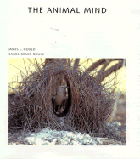
|
The Animal MindJames L. Gould, Carol Grant Gould - 1994ISBN 0-7167-5046-5 |
Chimpanzees using ign language - are they communicating or responding as trained? Termintes cutting airshafts into their nests - do they understand ventilation? Green herons attrackting fish by tossing breadcrums into the water - a trick learned by watching human anglers?
Do these animals "know" what they are doing?
Only teo decades ago, responses to the suggestion that nonhuman animals solve problems, even think, ranged from polite dismissal to outright disdain. But now, new information is raising doubts in some of the most entrenched skeptics. It is no longer a certainty that animal merely react without awareness - nor is it clear that the gulf between animals and human consciousness is as wide as some would think.
In this engaging volume, James and Carol Gould go in search of the animal mind. Taking a fresh look at the evidence on animal capacities for perception, thought, and language, the Goulds show how scientists attempt to distinguish actions that go beyond the innate or automatically learned. They provide captivating, beautifully-illustrated descriptions of a number of clever and curious animal behaviors - some revealed to be more or less preprogrammed, some seemingly proof of a well-developed mental life.
The Goulds conclude by examining what animal consciousness studies have revealed about one species in particular: ourselves. Here these expert authors, who once counted themselves among the skeptics, show just how much opinions have changed. They suggest that human and animal consciousness may differ in degree of complexity, but not necessarily in kind, and that the study of other animal minds can tell us much about our own. It is a provocative closing for this examination of one of modern science's most controversial topics.